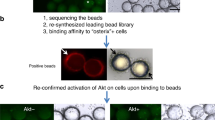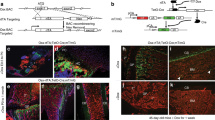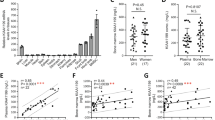Abstract
The ageing skeleton experiences a progressive decline in the rate of bone formation, which can eventually result in osteoporosis—a common disease characterized by reduced bone mass and altered bone microarchitecture which can result in fractures. One emerging therapy involves the identification of molecules that target bone-marrow mesenchymal stromal cells (MSCs) and promote their differentiation into osteoblasts, thereby counteracting bone loss. This Review highlights the discovery that some integrins, a family of heterodimeric transmembrane proteins that can interact with matrix proteins and generate intracellular signals, can be targeted to promote homing of MSCs to bone, osteogenic differentiation and bone formation. Specifically, priming of the α5β1 integrin, which is required for osteoblastic differentiation of MSCs, leads to increased bone formation and improved bone repair in mice. Additionally, treatment with a peptidomimetic ligand of the α4β1 integrin coupled to an agent with a high affinity for bone improves the homing of MSCs to bone and promotes osteoblast differentiation and bone formation, leading to increased bone mass in osteopenic mice. Strategies that target key integrins expressed by MSCs might, therefore, translate into improved therapies for age-related bone loss and possibly other disorders.
Key Points
-
Novel approaches for promoting osteogenic differentiation of mesenchymal stromal cells (MSCs) and improving bone formation and repair need to be developed for the treatment of age-related skeletal disorders
-
Extracellular matrix–integrin interactions control both osteoblastogenesis and bone formation
-
Complexes of integrin-targeted agents associated with an antiosteoporotic agent with high affinity for bone showed improved treatment efficacy in osteopenic mouse models
-
Approaches that target α4β1 and α5β1 integrins may lead to the development of novel strategies to increase bone formation in age-related bone loss and promote repair of non-healing fractures in humans
This is a preview of subscription content, access via your institution
Access options
Subscribe to this journal
Receive 12 print issues and online access
$209.00 per year
only $17.42 per issue
Buy this article
- Purchase on Springer Link
- Instant access to full article PDF
Prices may be subject to local taxes which are calculated during checkout



Similar content being viewed by others
References
Raisz, L. G. Pathogenesis of osteoporosis: concepts, conflicts, and prospects. J. Clin. Invest. 115, 3318–3325 (2005).
Khosla, S. & Riggs, B. L. Pathophysiology of age-related bone loss and osteoporosis. Endocrinol. Metab. Clin. North Am. 34, 1015–1030 (2005).
Riggs, B. L. & Parfitt, A. M. Drugs used to treat osteoporosis: the critical need for a uniform nomenclature based on their action on bone remodeling. J. Bone Miner. Res. 20, 177–184 (2005).
Marie, P. J. & Kassem, M. Osteoblasts in osteoporosis: past, emerging and future anabolic targets. Eur. J. Endocrinol. 165, 1–10 (2011).
Kassem, M. & Marie, P. J. Senescence-associated intrinsic mechanisms of osteoblast dysfunctions. Aging Cell 10, 191–197 (2011).
Marie, P. J. & Kassem, M. Extrinsic mechanisms involved in age-related defective bone formation. J. Clin. Endocrinol. Metab. 96, 600–609 (2011).
Aubin, J. E. Regulation of osteoblast formation and function. Rev. Endocr. Metab. Disord. 2, 81–94 (2001).
Lian, J. B. et al. Regulatory controls for osteoblast growth and differentiation: role of Runx/Cbfa/AML factors. Crit. Rev. Eukaryot. Gene Expr. 14, 1–41 (2004).
Karsenty, G. Minireview: transcriptional control of osteoblast differentiation. Endocrinology 142, 2731–2733 (2001).
Marie, P. J. Transcription factors controlling osteoblastogenesis. Arch. Biochem. Biophys. 473, 98–105 (2008).
Long, F. Building strong bones: molecular regulation of the osteoblast lineage. Nat. Rev. Mol. Cell Biol. 13, 27–38 (2012).
Bianco, P. & Gehron Robey, P. Marrow stromal stem cells. J. Clin. Invest. 105, 1663–1668 (2000).
Prockop, D. J., Gregory, C. A. & Spees, J. L. One strategy for cell and gene therapy: harnessing the power of adult stem cells to repair tissues. Proc. Natl Acad. Sci. USA 100 (Suppl. 1), 11917–11923 (2003).
Bianco, P. & Robey, P. G. Stem cells in tissue engineering. Nature 414, 118–121 (2001).
Prockop, D. J. Repair of tissues by adult stem/progenitor cells (MSCs): controversies, myths, and changing paradigms. Mol. Ther. 17, 939–946 (2009).
Bianco, P., Riminucci, M., Gronthos, S. & Robey, P. G. Bone marrow stromal stem cells: nature, biology, and potential applications. Stem Cells 19, 180–192 (2001).
Marie, P. J. & Fromigué, O. Osteogenic differentiation of human marrow-derived mesenchymal stem cells. Regen. Med. 1, 539–548 (2006).
Rosen, V. BMP2 signaling in bone development and repair. Cytokine Growth Factor Rev. 20, 475–480 (2009).
Bodine, P. V. & Komm, B. S. Wnt signaling and osteoblastogenesis. Rev. Endocr. Metab. Disord. 7, 33–39 (2006).
Plow, E. F., Haas, T. A., Zhang, L., Loftus, J. & Smith, J. W. Ligand binding to integrins. J. Biol. Chem. 275, 21785–21788 (2000).
Campbell, I. D. & Humphries, M. J. Integrin structure, activation, and interactions. Cold Spring Harb. Perspect. Biol. 3, 3 (2011).
Hynes, R. O. Integrins: bidirectional, allosteric signaling machines. Cell 110, 673–687 (2002).
Mould, A. P. & Humphries, M. J. Regulation of integrin function through conformational complexity: not simply a knee-jerk reaction? Curr. Opin. Cell. Biol. 16, 544–551 (2004).
Luo, B. H. & Springer, T. A. Integrin structures and conformational signaling. Curr. Opin. Cell Biol. 18, 579–586 (2006).
Askari, J. A., Buckley, P. A., Mould, A. P. & Humphries, M. J. Linking integrin conformation to function. J. Cell Sci. 122, 165–170 (2009).
Giancotti, F. G. & Ruoslahti, E. Integrin signaling. Science 285, 1028–1032 (1999).
Mitra, S. K. & Schlaepfer, D. D. Integrin-regulated FAK-Src signaling in normal and cancer cells. Curr. Opin. Cell Biol. 18, 516–523 (2006).
Chen, X. & Gumbiner, B. M. Crosstalk between different adhesion molecules. Curr. Opin. Cell Biol. 18, 572–578 (2006).
Damsky, C. H. & Ilic, D. Integrin signaling: it's where the action is. Curr. Opin. Cell Biol. 14, 594–602 (2002).
Ginsberg, M. H., Partridge, A. & Shattil, S. J. Integrin regulation. Curr. Opin. Cell Biol. 17, 509–516 (2005).
Humphries, J. D., Byron, A. & Humphries, M. J. Integrin ligands at a glance. J. Cell Sci. 119, 3901–3903 (2006).
Larsen, M., Artym, V. V., Green, J. A. & Yamada, K. M. The matrix reorganized: extracellular matrix remodeling and integrin signaling. Curr. Opin. Cell Biol. 18, 463–471 (2006).
Bershadsky, A., Kozlov, M. & Geiger, B. Adhesion-mediated mechanosensitivity: a time to experiment, and a time to theorize. Curr. Opin. Cell. Biol. 18, 472–481 (2006).
Bouvard, D. et al. Functional consequences of integrin gene mutations in mice. Circ. Res. 89, 211–223 (2001).
Bokel, C. & Brown, N. H. Integrins in development: moving on, responding to, and sticking to the extracellular matrix. Dev. Cell 3, 311–321 (2002).
Sanjay, A., Horne, W. C. & Baron, R. The Cbl family: ubiquitin ligases regulating signaling by tyrosine kinases. Sci. STKE 2001, PE40 (2001).
Duong, L. T., Lakkakorpi, P., Nakamura, I. & Rodan, G. A. Integrins and signaling in osteoclast function. Matrix Biol. 19, 97–105 (2000).
Ross, F. P. & Teitelbaum, S. L. αvβ3 and macrophage colony-stimulating factor: partners in osteoclast biology. Immunol. Rev. 208, 88–105 (2005).
Del Fattore, A., Teti, A. & Rucci, N. Osteoclast receptors and signaling. Arch. Biochem. Biophys. 473, 147–160 (2008).
Zou, W. & Teitelbaum, S. L. Integrins, growth factors, and the osteoclast cytoskeleton. Ann. NY Acad. Sci. 1192, 27–31 (2010).
Engleman, V. W. et al. A peptidomimetic antagonist of the α(v) β3 integrin inhibits bone resorption in vitro and prevents osteoporosis in vivo. J. Clin. Invest. 99, 2284–2292 (1997).
Lark, M. W. et al. Design and characterization of orally active Arg-Gly-Asp peptidomimetic vitronectin receptor antagonist SB 265123 for prevention of bone loss in osteoporosis. J. Pharmacol. Exp. Ther. 291, 612–617 (1999).
Horton, M. A. Integrin antagonists as inhibitors of bone resorption: implications for treatment. Proc. Nutr. Soc. 60, 275–281 (2001).
Cacciari, B. & Spalluto, G. Non peptidic αvβ3 antagonists: recent developments. Curr. Med. Chem. 12, 51–70 (2005).
Nakamura, I., Duong le, T., Rodan, S. B. & Rodan, G. A. Involvement of α(v)β3 integrins in osteoclast function. J. Bone Miner. Metab. 25, 337–344 (2007).
Crippes, B. A. et al. Antibody to β3 integrin inhibits osteoclast-mediated bone resorption in the thyroparathyroidectomized rat. Endocrinology 137, 918–924 (1996).
Murphy, M. G. et al. Effect of L-000845704, an αvβ3 integrin antagonist, on markers of bone turnover and bone mineral density in postmenopausal osteoporotic women. J. Clin. Endocrinol. Metab. 90, 2022–2028 (2005).
Zhao, H. et al. Critical role of β3 integrin in experimental postmenopausal osteoporosis. J. Bone Miner. Res. 20, 2116–2123 (2005).
Lane, N. E. et al. Mice lacking the integrin β5 subunit have accelerated osteoclast maturation and increased activity in the estrogen-deficient state. J. Bone Miner. Res. 20, 58–66 (2005).
Crotti, T. N. et al. NFATc1 regulation of the human β3 integrin promoter in osteoclast differentiation. Gene 372, 92–102 (2006).
Rao, H. et al. α9β1: a novel osteoclast integrin that regulates osteoclast formation and function. J. Bone Miner. Res. 21, 1657–1665 (2006).
Damsky, C. H. Extracellular matrix-integrin interactions in osteoblast function and tissue remodeling. Bone 25, 95–96 (1999).
Gronthos, S., Simmons, P. J., Graves, S. E. & Robey, P. G. Integrin-mediated interactions between human bone marrow stromal precursor cells and the extracellular matrix. Bone 28, 174–181 (2001).
Katsumi, A., Orr, A. W., Tzima, E. & Schwartz, M. A. Integrins in mechanotransduction. J. Biol. Chem. 279, 12001–12004 (2004).
Thompson, W. R., Rubin, C. T. & Rubin, J. Mechanical regulation of signaling pathways in bone. Gene 503, 179–193 (2012).
Franceschi, R. T. et al. Multiple signaling pathways converge on the Cbfa1/Runx2 transcription factor to regulate osteoblast differentiation. Connect. Tissue Res. 44 (Suppl. 1), 109–116 (2003).
Marie, P. J. Bone cell-matrix protein interactions. Osteoporos. Int. 20, 1037–1042 (2009).
Bennett, J. H., Carter, D. H., Alavi, A. L., Beresford, J. N. & Walsh, S. Patterns of integrin expression in a human mandibular explant model of osteoblast differentiation. Arch. Oral Biol. 46, 229–238 (2001).
Shekaran, A. & Garcia, A. J. Extracellular matrix-mimetic adhesive biomaterials for bone repair. J. Biomed. Mater. Res. A 96, 261–272 (2011).
Matter, M. L. & Ruoslahti, E. A signaling pathway from the α5β1 and α(v) β3 integrins that elevates bcl-2 transcription. J. Biol. Chem. 276, 27757–27763 (2001).
Howe, A. K., Aplin, A. E. & Juliano, R. L. Anchorage-dependent ERK signaling—mechanisms and consequences. Curr. Opin. Genet. Dev. 12, 30–35 (2002).
Wang, Z., Telci, D. & Griffin, M. Importance of syndecan-4 and syndecan-2 in osteoblast cell adhesion and survival mediated by a tissue transglutaminase-fibronectin complex. Exp. Cell Res. 317, 367–381 (2011).
Kaabeche, K. et al. Cbl-mediated ubiquitination of α5 integrin subunit mediates fibronectin-dependent osteoblast detachment and apoptosis induced by FGFR2 activation. J. Cell Sci. 118, 1223–1232 (2005).
Dufour, C., Holy, X. & Marie, P. J. Skeletal unloading induces osteoblast apoptosis and targets α5β1-PI3K-Bcl-2 signaling in rat bone. Exp. Cell. Res. 313, 394–403 (2007).
Watabe, H., Furuhama, T., Tani-Ishii, N. & Mikuni-Takagaki, Y. Mechanotransduction activates α(5) β(1) integrin and PI3K/Akt signaling pathways in mandibular osteoblasts. Exp. Cell. Res. 317, 2642–2649 (2011).
Batra, N. et al. Mechanical stress-activated integrin α5β1 induces opening of connexin 43 hemichannels. Proc. Natl Acad. Sci. USA 109, 3359–3364 (2012).
Zimmerman, D., Jin, F., Leboy, P., Hardy, S. & Damsky, C. Impaired bone formation in transgenic mice resulting from altered integrin function in osteoblasts. Dev. Biol. 220, 2–15 (2000).
Globus, R. K. et al. Skeletal phenotype of growing transgenic mice that express a function-perturbing form of β1 integrin in osteoblasts. Calcif. Tissue Int. 76, 39–49 (2005).
Iwaniec, U. T. et al. Effects of disrupted β1-integrin function on the skeletal response to short-term hindlimb unloading in mice. J. Appl. Physiol. 98, 690–696 (2005).
Bouvard, D. et al. Defective osteoblast function in ICAP-1-deficient mice. Development 134, 2615–2625 (2007).
Brunner, M. et al. Osteoblast mineralization requires β1 integrin/ICAP-1-dependent fibronectin deposition. J. Cell Biol. 194, 307–322 (2011).
Yeh, C. R. et al. Estrogen augments shear stress-induced signaling and gene expression in osteoblast-like cells via estrogen receptor-mediated expression of β1-integrin. J. Bone Miner. Res. 25, 627–639 (2010).
Park, S. J. et al. The forkhead transcription factor Foxc2 promotes osteoblastogenesis via up-regulation of integrin β1 expression. Bone 49, 428–438 (2011).
Nesti, L. J. et al. TGF-β1 calcium signaling increases α5 integrin expression in osteoblasts. J. Orthop. Res. 20, 1042–1049 (2002).
Dufour, C., Holy, X. & Marie, P. J. Transforming growth factor-β prevents osteoblast apoptosis induced by skeletal unloading via PI3K/Akt, Bcl-2, and phospho-Bad signaling. Am. J. Physiol. Endocrinol. Metab. 294, E794–E801 (2008).
Ono, M., Inkson, C. A., Kilts, T. M. & Young, M. F. WISP-1/CCN4 regulates osteogenesis by enhancing BMP-2 activity. J. Bone Miner. Res. 26, 193–208 (2011).
Salasznyk, R. M., Klees, R. F., Boskey, A. & Plopper, G. E. Activation of FAK is necessary for the osteogenic differentiation of human mesenchymal stem cells on laminin-5. J. Cell. Biochem. 100, 499–514 (2007).
McBeath, R., Pirone, D. M., Nelson, C. M., Bhadriraju, K. & Chen, C. S. Cell shape, cytoskeletal tension, and RhoA regulate stem cell lineage commitment. Dev. Cell. 6, 483–495 (2004).
Khatiwala, C. B., Kim, P. D., Peyton, S. R. & Putnam, A. J. ECM compliance regulates osteogenesis by influencing MAPK signaling downstream of RhoA and ROCK. J. Bone Miner. Res. 24, 886–898 (2009).
Carvalho, R. S., Bumann, A., Schaffer, J. L. & Gerstenfeld, L. C. Predominant integrin ligands expressed by osteoblasts show preferential regulation in response to both cell adhesion and mechanical perturbation. J. Cell. Biochem. 84, 497–508 (2002).
Pommerenke, H. et al. The mode of mechanical integrin stressing controls intracellular signaling in osteoblasts. J. Bone Miner. Res. 17, 603–611 (2002).
Boutahar, N., Guignandon, A., Vico, L. & Lafage-Proust, M. H. Mechanical strain on osteoblasts activates autophosphorylation of focal adhesion kinase and proline-rich tyrosine kinase 2 tyrosine sites involved in ERK activation. J. Biol. Chem. 279, 30588–30599 (2004).
Young, S. R., Gerard- O'Riley, R., Kim, J. B. & Pavalko, F. M. Focal adhesion kinase is important for fluid shear stress-induced mechanotransduction in osteoblasts. J. Bone Miner. Res. 24, 411–424 (2009).
Hamidouche, Z. et al. Priming integrin α5 promotes human mesenchymal stromal cell osteoblast differentiation and osteogenesis. Proc. Natl Acad. Sci. USA 106, 18587–18591 (2009).
Kim, J. B. et al. Reconciling the roles of FAK in osteoblast differentiation, osteoclast remodeling, and bone regeneration. Bone 41, 39–51 (2007).
Popov, C. et al. Integrins α2β1 and α11β1 regulate the survival of mesenchymal stem cells on collagen I. Cell. Death Dis. 2, e186 (2011).
Shih, Y. R., Tseng, K. F., Lai, H. Y., Lin, C. H. & Lee, O. K. Matrix stiffness regulation of integrin-mediated mechanotransduction during osteogenic differentiation of human mesenchymal stem cells. J. Bone Miner. Res. 26, 730–738 (2011).
Cheng, S. L. et al. Regulation of αVβ3 and αVβ5 integrins by dexamethasone in normal human osteoblastic cells. J. Cell. Biochem. 77, 265–276 (2000).
Su, J. L. et al. CYR61 regulates BMP-2-dependent osteoblast differentiation through the αvβ3 integrin/integrin-linked kinase/ERK pathway. J. Biol. Chem. 285, 31325–31336 (2010).
Blumbach, K. et al. Dwarfism in mice lacking collagen-binding integrins α2β1 and α11β1 is caused by severely diminished IGF-1 levels. J. Biol. Chem. 287, 6431–6440 (2012).
Tucker, G. C. Integrins: molecular targets in cancer therapy. Curr. Oncol. Rep. 8, 96–103 (2006).
Millard, M., Odde, S. & Neamati, N. Integrin targeted therapeutics. Theranostics 1, 154–188 (2011).
Cox, D., Brennan, M. & Moran, N. Integrins as therapeutic targets: lessons and opportunities. Nat. Rev. Drug Discov. 9, 804–820 (2010).
Humphries, M. J. Integrin structure. Biochem. Soc. Trans. 28, 311–339 (2000).
Hamidouche, Z., Fromigué, O., Ringe, J., Haüpl, T. & Marie, P. J. Crosstalks between integrin α5 and IGF2/IGFBP2 signalling trigger human bone marrow-derived mesenchymal stromal osteogenic differentiation. BMC Cell Biol. 11, 44 (2010).
Fromigué, O. et al. Peptide-based activation of α5 integrin for promoting osteogenesis. J. Cell. Biochem. 113, 3029–3038 (2012).
Srouji, S. et al. Lentiviral-mediated integrin α5 expression in human adult mesenchymal stromal cells promotes bone repair in mouse cranial and long-bone defects. Hum. Gene Ther. 23, 167–172 (2012).
Hartz, B. et al. α4 integrin levels on mobilized peripheral blood stem cells predict rapidity of engraftment in patients receiving autologous stem cell transplantation. Blood 118, 2362–2365 (2011).
Kumar, S. & Ponnazhagan, S. Bone homing of mesenchymal stem cells by ectopic α4 integrin expression. FASEB J. 21, 3917–3927 (2007).
Guan, M. et al. Directing mesenchymal stem cells to bone to augment bone formation and increase bone mass. Nat. Med. 18, 456–462 (2012).
Lu, X. et al. VCAM-1 promotes osteolytic expansion of indolent bone micrometastasis of breast cancer by engaging a4β1-positive osteoclast progenitors. Cancer Cell 20, 701–714 (2011).
Seeman, E. Pathogenesis of bone fragility in women and men. Lancet 359, 1841–1850 (2002).
Anselme, K. Osteoblast adhesion on biomaterials. Biomaterials 21, 667–681 (2000).
Meyer, A., Auernheimer, J., Modlinger, A. & Kessler, H. Targeting RGD recognizing integrins: drug development, biomaterial research, tumor imaging and targeting. Curr. Pharm. Des. 12, 2723–2747 (2006).
Mukherjee, S. et al. Pharmacologic targeting of a stem/progenitor population in vivo is associated with enhanced bone regeneration in mice. J. Clin. Invest. 118, 491–504 (2008).
Jilka, R. L. Molecular and cellular mechanisms of the anabolic effect of intermittent PTH. Bone 40, 1434–1446 (2007).
Compston, J. E. Skeletal actions of intermittent parathyroid hormone: effects on bone remodelling and structure. Bone 40, 1447–1452 (2007).
Acknowledgements
The author's research work discussed in this paper was supported in part by INSERM and University Paris Diderot, the Agence Nationale de la Recherche (grant number ANR-2010-BLAN-1505-01, Integros) and the Fondation de l'Avenir pour la Recherche Appliquée, Paris, France (grant ET9-521). The author thanks Drs G. Tucker and D. Bouvard for their comments, and Z. Saidak for language corrections.
Author information
Authors and Affiliations
Ethics declarations
Competing interests
The author declares that he is an inventor on patent application numbers WO2010015938 (A2) WO2010015938 (A3) and EP2328924 (A2).
Rights and permissions
About this article
Cite this article
Marie, P. Targeting integrins to promote bone formation and repair. Nat Rev Endocrinol 9, 288–295 (2013). https://doi.org/10.1038/nrendo.2013.4
Published:
Issue Date:
DOI: https://doi.org/10.1038/nrendo.2013.4
This article is cited by
-
Targeting strategies for bone diseases: signaling pathways and clinical studies
Signal Transduction and Targeted Therapy (2023)
-
Comprehensive ceRNA network for MACF1 regulates osteoblast proliferation
BMC Genomics (2022)
-
Targeted activation of androgen receptor signaling in the periosteum improves bone fracture repair
Cell Death & Disease (2022)
-
KAT6A regulates stemness of aging bone marrow-derived mesenchymal stem cells through Nrf2/ARE signaling pathway
Stem Cell Research & Therapy (2021)
-
CircRNA-vgll3 promotes osteogenic differentiation of adipose-derived mesenchymal stem cells via modulating miRNA-dependent integrin α5 expression
Cell Death & Differentiation (2021)



